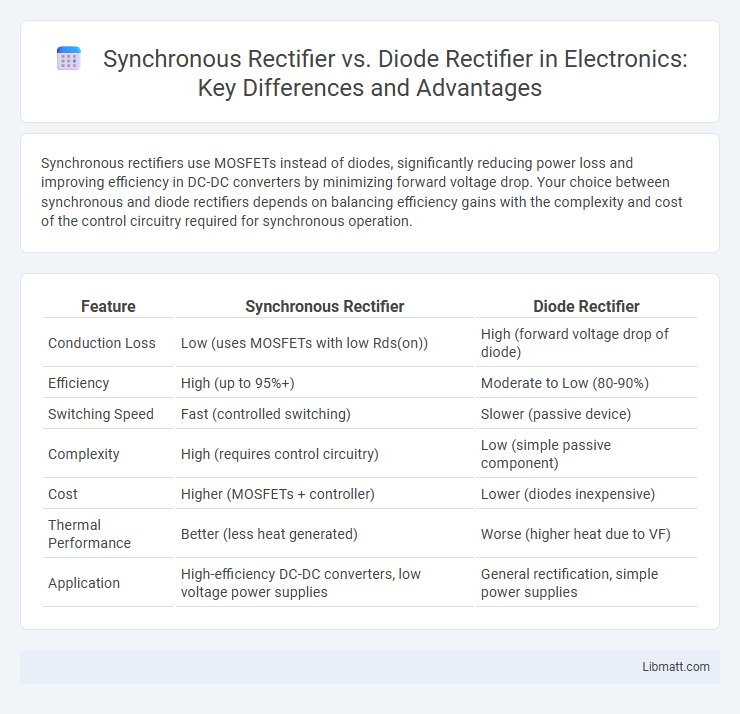Synchronous rectifiers use MOSFETs instead of diodes, significantly reducing power loss and improving efficiency in DC-DC converters by minimizing forward voltage drop. Your choice between synchronous and diode rectifiers depends on balancing efficiency gains with the complexity and cost of the control circuitry required for synchronous operation.
Table of Comparison
| Feature | Synchronous Rectifier | Diode Rectifier |
|---|---|---|
| Conduction Loss | Low (uses MOSFETs with low Rds(on)) | High (forward voltage drop of diode) |
| Efficiency | High (up to 95%+) | Moderate to Low (80-90%) |
| Switching Speed | Fast (controlled switching) | Slower (passive device) |
| Complexity | High (requires control circuitry) | Low (simple passive component) |
| Cost | Higher (MOSFETs + controller) | Lower (diodes inexpensive) |
| Thermal Performance | Better (less heat generated) | Worse (higher heat due to VF) |
| Application | High-efficiency DC-DC converters, low voltage power supplies | General rectification, simple power supplies |
Introduction to Rectifiers
Synchronous rectifiers use MOSFETs to replace diodes, significantly reducing conduction losses and improving efficiency in power conversion systems compared to traditional diode rectifiers. Diode rectifiers rely on semiconductor diodes to convert AC to DC, but their fixed voltage drop causes higher power dissipation and lower efficiency at high current levels. Synchronous rectification is preferred in modern applications such as power supplies and DC-DC converters for its enhanced performance and reduced thermal stress.
Overview of Synchronous Rectifiers
Synchronous rectifiers are power electronic devices that replace traditional diodes with MOSFETs to reduce conduction losses in power conversion circuits. These rectifiers improve efficiency by actively switching at the right intervals, minimizing voltage drop compared to diode rectifiers. Commonly used in low-voltage, high-current applications, synchronous rectifiers enhance energy savings and thermal management in DC-DC converters and power supplies.
Overview of Diode Rectifiers
Diode rectifiers convert AC to DC using semiconductor diodes that allow current flow in one direction, providing simple and reliable rectification. These devices are widely used in power supplies due to their low cost and ease of implementation but suffer from voltage drops around 0.7V, causing efficiency losses. Your choice between diode and synchronous rectifiers depends on application demands, as diode rectifiers typically result in higher power dissipation compared to synchronous rectifiers.
Key Differences Between Synchronous and Diode Rectifiers
Synchronous rectifiers use MOSFETs controlled by external circuitry to minimize conduction losses, offering higher efficiency compared to traditional diode rectifiers that rely on semiconductor diodes with fixed voltage drops. Diode rectifiers are simpler and more cost-effective but generate more heat and reduce power efficiency due to their higher forward voltage drop. Your choice between these rectifiers depends on efficiency requirements, cost constraints, and thermal management capabilities in the application.
Efficiency Comparison: Synchronous vs Diode Rectifiers
Synchronous rectifiers achieve significantly higher efficiency than diode rectifiers by using MOSFETs with low on-resistance to minimize conduction losses, often improving efficiency by 5-10% in power conversion applications. Diode rectifiers inherently suffer from forward voltage drops (typically 0.7V for silicon diodes), resulting in greater power dissipation, especially at high currents. The efficiency advantage of synchronous rectifiers is most prominent in low-voltage, high-current scenarios, where reduced power loss translates directly into improved thermal management and system performance.
Power Loss Analysis in Rectifiers
Synchronous rectifiers use MOSFETs instead of diodes, significantly reducing conduction losses due to their lower on-resistance (R_DS(on)) compared to diode forward voltage drop (V_F). Diode rectifiers experience higher power loss primarily from the fixed forward voltage drop, typically 0.7V per diode in silicon diodes, leading to increased heat dissipation and lower efficiency in high-current applications. The reduced conduction losses in synchronous rectifiers enable improved efficiency, especially in low-voltage, high-current power supplies where power loss directly impacts thermal performance and energy consumption.
Applications of Synchronous Rectifiers
Synchronous rectifiers are widely used in high-efficiency power supplies, including DC-DC converters and battery-powered devices, where reducing conduction losses is crucial. Their ability to replace traditional diodes with low-resistance MOSFETs makes them ideal for applications in computer power supplies, electric vehicles, and renewable energy systems. You can improve overall energy efficiency and thermal management in these systems by choosing synchronous rectifiers over conventional diode rectifiers.
Applications of Diode Rectifiers
Diode rectifiers are widely used in low-cost power supplies, battery chargers, and simple DC motor drive circuits due to their robustness and ease of implementation. They are common in applications that require low-frequency conversion and where efficiency is less critical, such as in household appliances and small electronic devices. Their ability to handle high voltages and currents makes diode rectifiers suitable for industrial power rectification and basic power conversion tasks.
Cost and Design Considerations
Synchronous rectifiers offer higher efficiency than diode rectifiers by using controlled MOSFETs instead of passive diodes, resulting in reduced conduction losses but at a higher component cost and increased design complexity. Diode rectifiers are simpler, cheaper, and easier to implement with fewer control requirements, making them suitable for cost-sensitive, low-efficiency applications. Designers must balance the higher initial cost and complexity of synchronous rectifiers against long-term energy savings and improved thermal performance.
Choosing the Right Rectifier for Your Application
Synchronous rectifiers offer higher efficiency and reduced power loss compared to diode rectifiers, making them ideal for applications requiring improved energy savings and thermal management. Diode rectifiers are simpler, more cost-effective, and suitable for lower-power designs or where efficiency is less critical. Your choice depends on balancing factors like efficiency requirements, cost constraints, and the complexity of the power supply design.
Synchronous rectifier vs Diode rectifier Infographic

 libmatt.com
libmatt.com